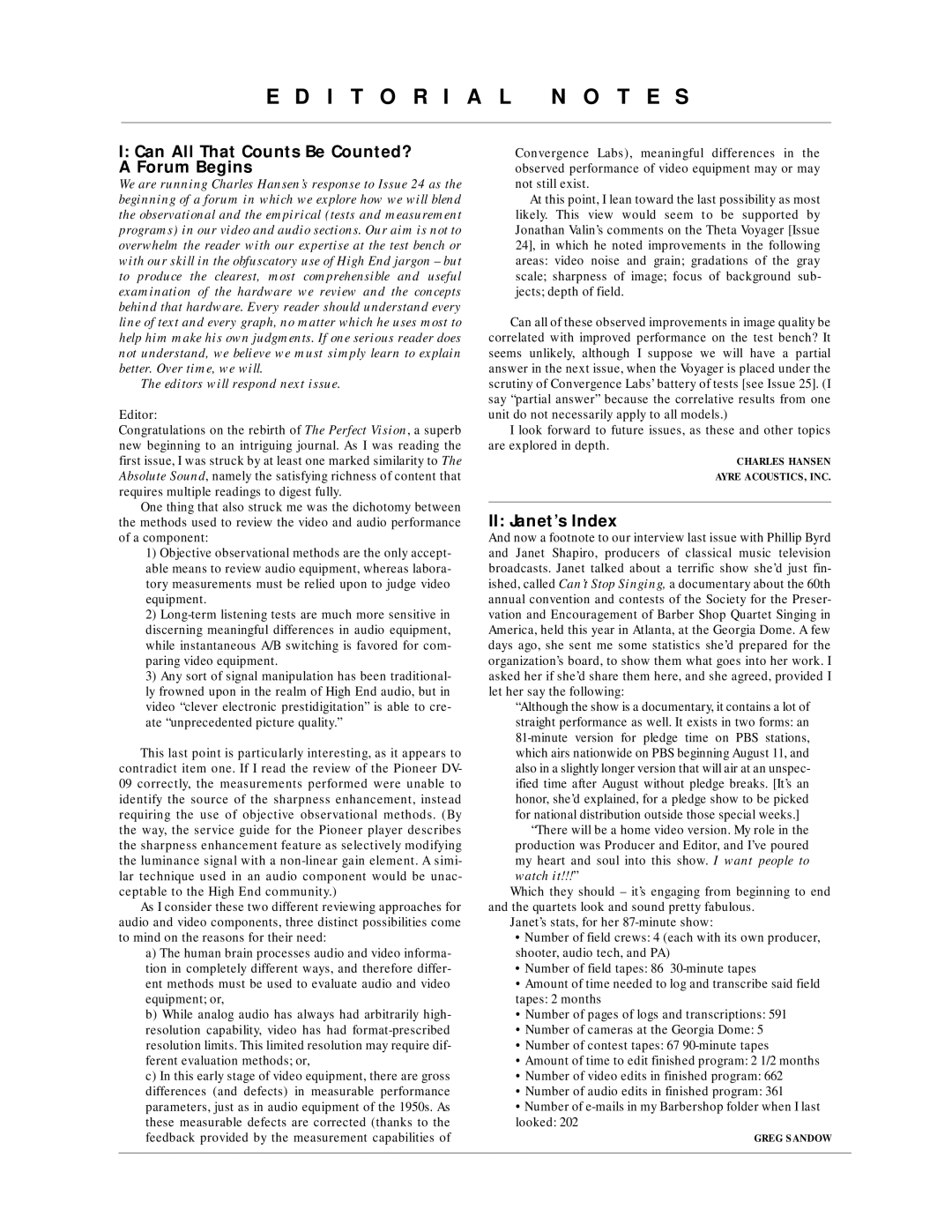
E D I T O R I A L N O T E S
I:Can All That Counts Be Counted? A Forum Begins
We are running Charles Hansen’s response to Issue 24 as the beginning of a forum in which we explore how we will blend the observational and the empirical (tests and measurement programs) in our video and audio sections. Our aim is not to overwhelm the reader with our expertise at the test bench or with our skill in the obfuscatory use of High End jargon – but to produce the clearest, most comprehensible and useful examination of the hardware we review and the concepts behind that hardware. Every reader should understand every line of text and every graph, no matter which he uses most to help him make his own judgments. If one serious reader does not understand, we believe we must simply learn to explain better. Over time, we will.
The editors will respond next issue.
Editor:
Congratulations on the rebirth of The Perfect Vision, a superb new beginning to an intriguing journal. As I was reading the first issue, I was struck by at least one marked similarity to The Absolute Sound, namely the satisfying richness of content that requires multiple readings to digest fully.
One thing that also struck me was the dichotomy between the methods used to review the video and audio performance of a component:
1)Objective observational methods are the only accept- able means to review audio equipment, whereas labora- tory measurements must be relied upon to judge video equipment.
2)
3)Any sort of signal manipulation has been traditional- ly frowned upon in the realm of High End audio, but in video “clever electronic prestidigitation” is able to cre- ate “unprecedented picture quality.”
This last point is particularly interesting, as it appears to contradict item one. If I read the review of the Pioneer DV- 09 correctly, the measurements performed were unable to identify the source of the sharpness enhancement, instead requiring the use of objective observational methods. (By the way, the service guide for the Pioneer player describes the sharpness enhancement feature as selectively modifying the luminance signal with a
As I consider these two different reviewing approaches for audio and video components, three distinct possibilities come to mind on the reasons for their need:
a)The human brain processes audio and video informa- tion in completely different ways, and therefore differ- ent methods must be used to evaluate audio and video equipment; or,
b)While analog audio has always had arbitrarily high- resolution capability, video has had
c)In this early stage of video equipment, there are gross differences (and defects) in measurable performance parameters, just as in audio equipment of the 1950s. As these measurable defects are corrected (thanks to the feedback provided by the measurement capabilities of
Convergence Labs), meaningful differences in the observed performance of video equipment may or may not still exist.
At this point, I lean toward the last possibility as most likely. This view would seem to be supported by Jonathan Valin’s comments on the Theta Voyager [Issue 24], in which he noted improvements in the following areas: video noise and grain; gradations of the gray scale; sharpness of image; focus of background sub- jects; depth of field.
Can all of these observed improvements in image quality be correlated with improved performance on the test bench? It seems unlikely, although I suppose we will have a partial answer in the next issue, when the Voyager is placed under the scrutiny of Convergence Labs’ battery of tests [see Issue 25]. (I say “partial answer” because the correlative results from one unit do not necessarily apply to all models.)
I look forward to future issues, as these and other topics are explored in depth.
CHARLES HANSEN
AYRE ACOUSTICS, INC.
II: Janet’s Index
And now a footnote to our interview last issue with Phillip Byrd and Janet Shapiro, producers of classical music television broadcasts. Janet talked about a terrific show she’d just fin- ished, called Can’t Stop Singing, a documentary about the 60th annual convention and contests of the Society for the Preser- vation and Encouragement of Barber Shop Quartet Singing in America, held this year in Atlanta, at the Georgia Dome. A few days ago, she sent me some statistics she’d prepared for the organization’s board, to show them what goes into her work. I asked her if she’d share them here, and she agreed, provided I let her say the following:
“Although the show is a documentary, it contains a lot of straight performance as well. It exists in two forms: an
“There will be a home video version. My role in the production was Producer and Editor, and I’ve poured my heart and soul into this show. I want people to watch it!!!”
Which they should – it’s engaging from beginning to end and the quartets look and sound pretty fabulous.
Janet’s stats, for her
•Number of field crews: 4 (each with its own producer, shooter, audio tech, and PA)
•Number of field tapes: 86
•Amount of time needed to log and transcribe said field tapes: 2 months
•Number of pages of logs and transcriptions: 591
•Number of cameras at the Georgia Dome: 5
•Number of contest tapes: 67
•Amount of time to edit finished program: 2 1/2 months
•Number of video edits in finished program: 662
•Number of audio edits in finished program: 361
•Number of
GREG SANDOW
